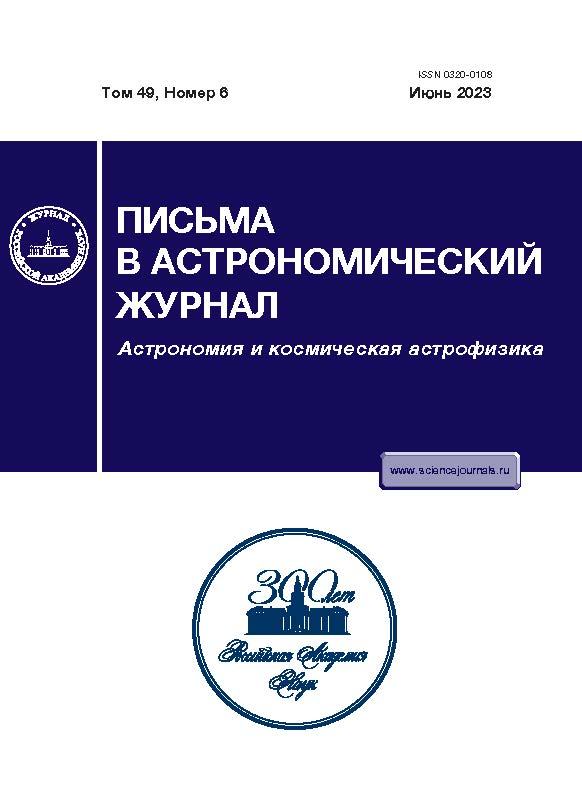What Can We Learn about Compton-thin AGN Tori from Their X-Ray Spectra?1
- Авторы: Melazzini F.1,2, Sazonov S.1
-
Учреждения:
- Space Research Institute, Russian Academy of Sciences
- Moscow Institute of Physics and Technology
- Выпуск: Том 49, № 6 (2023)
- Страницы: 399-400
- Раздел: Статьи
- URL: https://cardiosomatics.ru/0320-0108/article/view/674272
- DOI: https://doi.org/10.31857/S0320010823060050
- EDN: https://elibrary.ru/GPDELE
- ID: 674272
Цитировать
Полный текст
Аннотация
We have developed a Monte Carlo code for simulation of X-ray spectra of active galactic nuclei (AGN) based on a model of a clumpy obscuring torus. Using this code, we investigate the diagnostic power of X-ray spectroscopy of obscured AGN with respect to the physical properties and orientation of the torus, namely: the average column density, \(\langle N_{\textrm{H}}\rangle\), the line-of-sight column density, \(N_{\textrm{H}}\), the abundance of iron, \(A_{\textrm{Fe}}\), the clumpiness (i.e. the average number of gas clouds along the line of sight), \(\langle N\rangle\), and the viewing angle, \(\alpha\). In this first paper of a series, we consider the Compton-thin case, where both \(\langle N_{\textrm{H}}\rangle\) and \(N_{\textrm{H}}\) do not exceed \(10^{24}\) cm\({}^{-2}\). To enable quantitative comparison of the simulated spectra, we introduce five measurable spectral characteristics: the low-energy hardness ratio (ratio of the continuum fluxes in the 7–11 keV and 2–7 keV energy bands), the high-energy hardness ratio (ratio of the continuum fluxes in the 10–100 keV and 2–10 keV energy bands), the depth of the iron K absorption edge, the equivalent width of the Fe K\(\alpha\) line, and the fraction of the Fe K\(\alpha\) flux contained in the Compton shoulder. We demonstrate that by means of X-ray spectroscopy it is possible to tightly constrain \(\langle N_{\textrm{H}}\rangle\), \(N_{\textrm{H}}\) and \(A_{\textrm{Fe}}\) in the Compton-thin regime, while there is degeneracy between clumpiness and viewing direction.
Об авторах
F. Melazzini
Space Research Institute, Russian Academy of Sciences; Moscow Institute of Physics and Technology
Email: sazonov@cosmos.ru
Russia, Moscow; Russia, Dolgoprudny
S. Sazonov
Space Research Institute, Russian Academy of Sciences
Автор, ответственный за переписку.
Email: sazonov@cosmos.ru
Russia, Moscow
Список литературы
- R. Antonucci, Ann. Rev. Astron. Astrophys. 31, 473 (1993).
- J. Buchner, M. Brightman, K. Nandra, R. Nikutta, F.E. Bauer, Astron. Astrophys. 629, A16 (2019).
- J. Buchner, M. Brightman, M. Balokovic, K. Wada, F.E. Bauer, K. Nandra, Astron. Astrophys. 651, A58 (2021).
- D. Burlon, M. Ajello, J. Greiner, A. Comastri, A. Merloni, N. Gehrels, Astrophys. J. 728, 58 (2011).
- C.P. Dullemond and I.M. van Bemmel, Astron. Astrophys. 436, 47 (2005).
- U. Feldman, Phys. Scr. 46, 202 (1992).
- A. Feltre, E. Hatziminaoglou, J. Fritz, A. Franceschini, MNRAS 426, 120 (2012).
- S. Furui, Y. Fukazawa, H. Odaka, T. Kawaguchi, M. Ohno, K. Hayashi, Astrophys. J. 818, 164 (2016).
- I.M. George and A.C. Fabian, MNRAS 249, 352 (1991).
- M. Guainazzi and S. Bianchi, MNRAS 374, 1290 (2007).
- R.C. Hickox and D.M. Alexander, Ann. Rev. Astron. Astrophys. 56, 625 (2018).
- J.S. Kaastra and R. Mewe, Astron. Astrophys. Suppl. Ser. 97, 443 (1993).
- Y. Liu and X. Li, Astrophys. J. 787, 52 (2014).
- Y. Liu and X. Li, IAU General Assembly, Meet. 29, 2249494 (2015).
- A. Malizia, S. Sazonov, L. Bassani, E. Pian, V. Beckmann, M. Molina, I. Mereminskiy, G. Belanger, New Astron. Rev. 90, 101545 (2020).
- A.G. Markowitz, M. Krumpe, R. Nikutta, MNRAS 439, 1403 (2014).
- A. Merloni, et al., MNRAS 437, 3550 (2014).
- M. Nenkova, Z. Ivezic, M. Elitzur, Astrophys. J. 570, L9 (2002).
- H. Netzer, Ann. Rev. Astron. Astrophys. Sov. Sci. Rev., Sect. E: Astrophys. Space Phys. Rev. 53, 365 (2015).
- L.A. Pozdnyakov, I.M. Sobol, R.A. Syunyaev, Sov. Sci. Rev., Sect. E: Astrophys. Space Phys. Rev. 2, 189 (1983).
- C. Ramos Almeida and C. Ricci, Nature Astron. 1, 679 (2017).
- C. Ramos Almeida, et al., Astrophys. J. 731, 92 (2011).
- C. Ricci, et al., Astrophys. J. 820, 5 (2016).
- G. Risaliti, M. Elvis, G. Fabbiano, A. Baldi, A. Zeza, Astrophys. J. 623, L93 (2005).
- G. Risaliti, M. Elvis, G. Fabbiano, A. Baldi, A. Zezas, M. Salvati, Astrophys. J. 659, L111 (2007).
- S.Y. Sazonov and M.G. Revnivtsev, Astron. Astrophys. 423, 469 (2004).
- S.Y. Sazonov and R.A. Sunyaev, Astrophys. J. 543, 28 (2000).
- S. Sazonov, M. Revnivtsev, R. Krivonos, E. Churazov, R. Sunyaev, Astron. Astrophys. 462, 57 (2007).
- S. Sazonov, E. Churazov, R. Krivonos, MNRAS 454, 1202 (2015).
- M. Stalevski, C. Ricci, Y. Ueda, P. Lira, J. Fritz, M. Baes, MNRAS 458, 2288 (2016).
- A.T. Steffen, A.J. Barger, L.L. Cowie, R.F. Mushotzky, Y. Yang, Astrophys. J. 596, L23 (2003).
- R.A. Sunyaev and E.M. Churazov, Astron. Lett. 22, 648 (1996).
- A. Tanimoto, Y. Ueda, H. Odaka, T. Kawaguchi, Y. Fukazawa, T. Kawamuro, Astrophys. J. 877, 95 (2019).
- Y. Ueda, M. Akiyama, K. Ohta, T. Miyaji, Astrophys. J. 598, 886 (2003).
- Y. Ueda, M. Akiyama, G. Hasinger, T. Miyaji, M.G. Watson, Astrophys. J. 786, 104 (2014).
- D.A. Verner and D.G. Yakovlev, Astron. Astrophys. Suppl. Ser. 109, 125 (1995).
- D.A. Verner, G.J. Ferland, K.T. Korista, D.G. Yakovlev, Astrophys. J. 465, 487 (1996).
Дополнительные файлы











